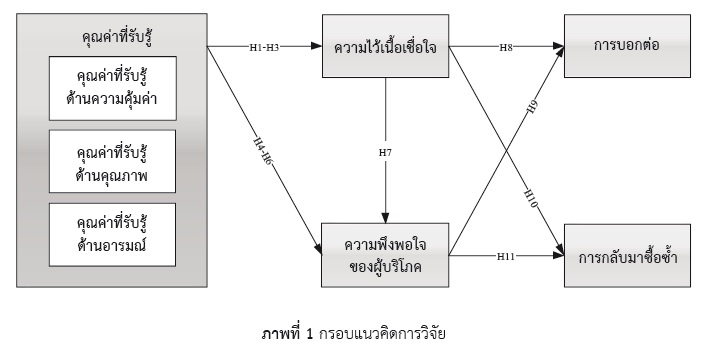The influences of perceived value on trust, satisfaction, word of mouth and repurchase of the healthy food consumers in Bangkok
Keywords:
Perceived Value, Trust, Satisfaction, Word of Mouth, RepurchaseAbstract
The objectives of this research were to develop and validate a causal relationship model of influence of perceived value on trust, satisfaction, word of mouth and repurchase of the healthy food consumers in Bangkok. The model involved seven latent variables: perceived economic value, perceived quality value and perceived emotional value as the independent variables; customer trust and satisfaction as mediating variables; and customer word of mouth and repurchase as dependent variables. The researchers used quantitative method which involved empirical research. The instrument of research was a questionnaire used to collect data from 400 of the healthy food consumers in Bangkok. The statistics used in data analysis were frequency distribution, percentage,
mean, standard deviation and structural equation model analysis. It was found that the model was consistent with the empirical data. Goodness of fit measures were found to be: Chi-square 392.850 (df=389, p-value=0.436); Relative Chi-square (χ2/df) 1.010;
Goodness of Fit Index (GFI) 0.947; Adjusted Goodness of Fit Index (AGFI) 0.906 and Root Mean Square Error of Approximation (RMSEA) 0.005. It was also found that: (1) perceived economic value, perceived quality value and perceived emotional value had positive and direct influence on trust of the healthy food consumers in Bangkok, (2) Perceived economic value, perceived quality value, perceived emotional value and trust had positive and direct influence on satisfaction of the healthy food consumers in Bangkok, (3) Satisfaction had positive and direct influence on word of mouth of the healthy food consumers in Bangkok, and (4) Trust and satisfaction had positive and direct influence on repurchase of the healthy food consumers in Bangkok
References
Anderson, E. W., Fornell, C., & Lehman, D. R. (1994). Customer satisfaction, market share and profitability: Findings from Sweden. Journal of Marketing, 58(3), 53-67.
Arndt, J. (1967). Role of product-related conversations in the diffusion of a new product. Journal of Marketing Research, 4(3), 291-295.
Bachunan, L., Simmons, C. J., & Bickart, B. A. (1999). Brand equity dilution: Retailer display and context brand effects. Journal of Marketing Research, 36(3), 345-355.
Brown, J. J., & Reingen, P. H. (1987). Social ties and word-of-mouth referral behavior. Journal of Consumer Research, 12(3), 350-362.
Callarisa Fiol, L. J., Bigne Alcañiz, E., Moliner Tena, M. A., & García, J. S. (2009). Customer loyalty in clusters: Perceived value and satisfaction as antecedents. Journal of Business-to-Business Marketing, 16(3), 276-316.
Caza, A., Zhang, G., Wang, L., & Bai, Y. (2015). How do you really feel? Effect of leaders’ perceived emotional sincerity on followers’ trust. The Leadership Quarterly, 26(4), 518-531.
Churchill, G., & Carol, S. (1982). An investigation into the determinants of customer satisfaction. Journal o f Marketing Research, 19(4), 491-504.
Esmail Alekam, J. M., Nik Mat, N. K., & Salleh, S. M. (2017). The significant role of communication, price, and quality in creating a brand trust to achieve purchase behavior antecedents and consequence of consumer brand trust. International Journal of Supply Chain Management, 6(4), 260-268.
Everitt, B. S., & Skrondal, A. (2010). The Cambridge dictionary of statistics (4th ed.). New York: Cambridge University Press.
Fandos Roig, J. C., García, J. S., & Moliner Tena, M. Á. (2009). Perceived value and customer loyalty in financial services. The Service Industries Journal, 29(6), 775-789.
Frank, B., Herbas Torrico, B., Enkawa, T., & Schvaneveldt, S. J. (2014). Affect versus cognition in the chain from perceived quality to customer loyalty: The roles of product beliefs and experience. Journal of Retailing, 90(4), 567-586.
Graf, A., & Maas, P. (2008). Customer value from a customer perspective: A comprehensive review. Journal für Betriebswirtschaft, 58(1), 1-20.
Ha, J., & Jang, S. (2010). Perceived values, satisfaction, and behavioral intentions: The role of familiarity in Korean restaurants. International Journal of Hospitality Management, 29(1), 2-13.
Hair, J. F., Jr., Black, W. C., Babin, B. J., & Anderson, R. E. (2014). Multivariate data analysis (7 ed.). Harow, Essex: Pearson.
Hsu, C.-L., & Lin, J. C.-C. (2015). What drives purchase intention for paid mobile apps? – An expectation confirmation model with perceived value. Electronic Commerce Research and Applications, 14(1), 46-57.
Hsu, L.-C. (2018). Investigating effect of service encounter, value, and satisfaction on word of mouth: An outpatient service context. International Journal of Environmental Research and Public Health, 15(1), 1-15.
Joaquín, A., & Magdalena, C. (2009). Analysing the effect of satisfaction and previous visits on tourist intentions to return. European Journal of Marketing, 43(5/6), 670-685.
Kisang, R., Heesup, H., & Soocheong, J. (2010). Relationships among hedonic and utilitarian values, satisfaction and behavioral intentions in the fast-casual restaurant industry. International Journal of Contemporary Hospitality Management, 22(3), 416-432.
Liang, L. J., Choi, H. C., & Joppe, M. (2018). Exploring the relationship between satisfaction, trust and switching intention, repurchase intention in the context of Airbnb. International Journal of Hospitality Management, 69, 41-48.
Marakanon, L., & Panjakajornsak, V. (2017). Perceived quality, perceived risk and customer trust affecting customer loyalty of environmentally friendly electronics products. Kasetsart Journal of Social Sciences, 38(1), 24-30.
Morgan, R. M., & Hunt, S. D. (1994). The commitment-trust theory of relationship marketing. Journal of Marketing, 58(1), 20-38.
Nadia, J., Sonia, S.-M., & Jose Ignacio, A. (2016). Trust and satisfaction: the keys to client loyalty in mobile commerce. Academia Revista Latinoamericana de Administración, 29(4), 486-510.
Nunnally, J. C. (1978). Psychometric theory (2nd ed.). New York: McGraw-Hill.
Oliver, R. L. (1997). Satisfaction: A behavioral perspective on the consumer. New York: McGraw-Hill.
Oliver, R. L., & DeSarbo, W. S. (1988). Response determinants in satisfaction judgments. Journal of Consumer Research, 14, 495-507.
Patterson, P. G., & Spreng, R. A. (1997). Modelling of the relationship between value, satisfaction and repurchase intention in a business-to-business, professional services context: An empirical investigation. International Journal of Service Industry Management, 8(5), 414-438.
Philipp, E. B., & Lisa, M. (2011). Perceived value: A critical examination of definitions, concepts and measures for the service industry. Journal of Services Marketing, 25(3), 229-240.
Rahadhini, M. D., Moeljadi, M., Rofiaty, R., & Sudjatno, S. (2016). Effect of perceived value on behavioral intention: Satisfaction and trust as mediation variables. International Journal of Economic Research, 13(4), 1423-1436
Reingen, P. H., & Kernan, J. B. (1986). Analysis of referral networks in marketing: methods and illustration. Journal of Marketing Research, 23(4), 370-378.
Richins, M. L. (1983). Negative word-of-mouth by dissatisfied consumers: A pilot study. Journal of Marketing, 47(1), 68-78.
Sweeney, J. C., & Soutar, N. G. (2001). Consumer perceived value: The development of a multiple item scale. Journal of Retailing, 77(2), 211-213.
Taghizadeh, H., Taghipourian, M. J., & Khazaei, A. (2013). The effect of customer satisfaction on word of mouth communication. Research Journal of Applied Sciences, Engineering and Technology, 5(8), 2569-2575.
TBP Group. (2015). Healhcare business, health focus, can be sold out. Retrieved 11 April, 2017, from http://www.tbp.co.th/news/new_trick/news_trick356.html
Um, S, Chon, K, Ro, & Y. (2006). Antecedents of revisit intention. Tourism, 33(4), 1141-1158.
Woodruff, R. B. (1997). Customer value: The next source for competitive advantage. Journal Academic Marketing Science, 25(2), 139-153.
Wu, H., & Lu, N. (2018). Service provision, pricing, and patient satisfaction in online health communities. International Journal of Medical Informatics, 110, 77-89.
Zeithaml, V. A. (1988). Consumer perceptions of price, quality and value: A means-end model and synthesis of evidence. Journal of Marketing, 52(3), 2-22.
Zeithaml, V. A., Bitner, M. J., & Dwayne, D. G. (2009). Services marketing: Integrating customer focus across the firm. Singapore: McGraw-Hill.

Downloads
Published
How to Cite
Issue
Section
License
Copyright (c) 2024 NIDA Business School, National Institute of Development Administration

This work is licensed under a Creative Commons Attribution-NonCommercial-NoDerivatives 4.0 International License.


